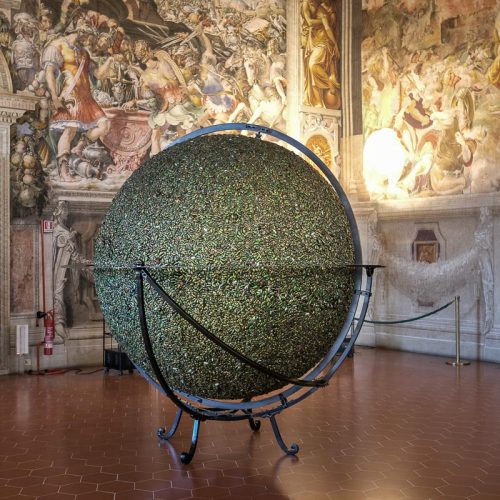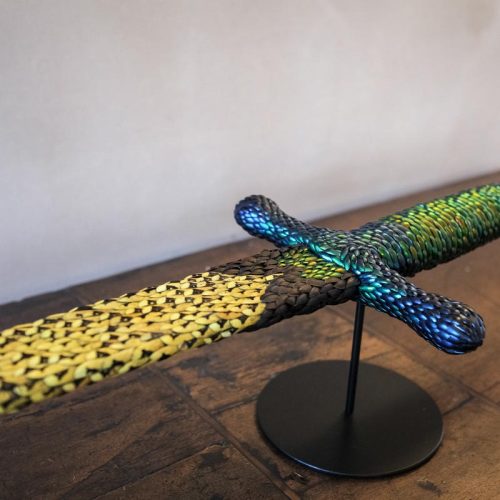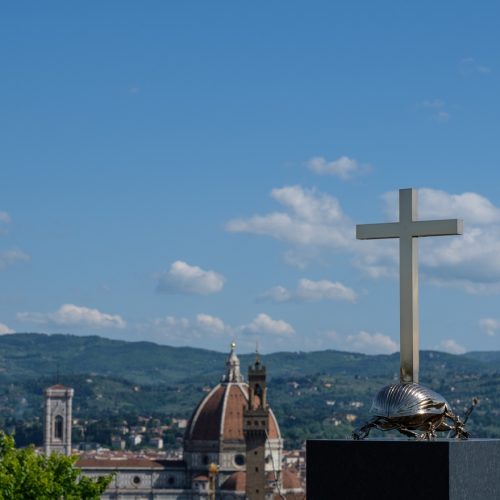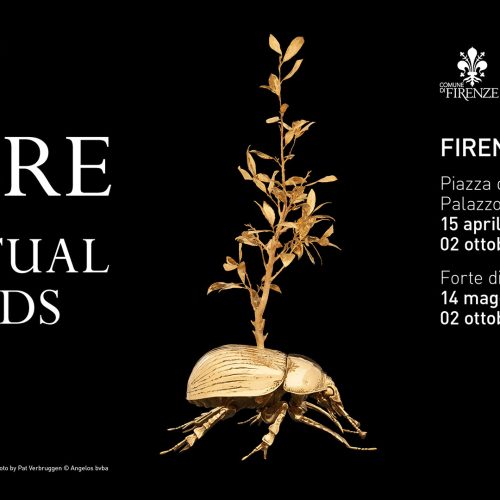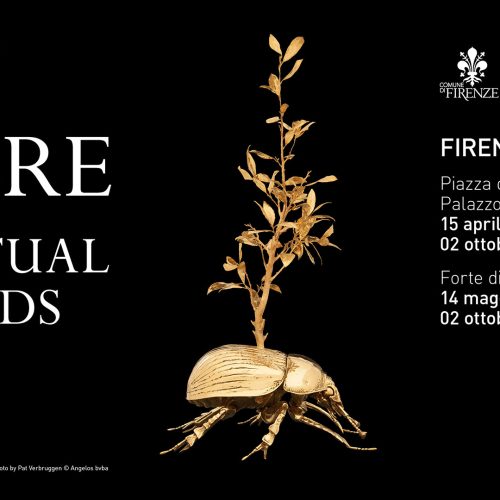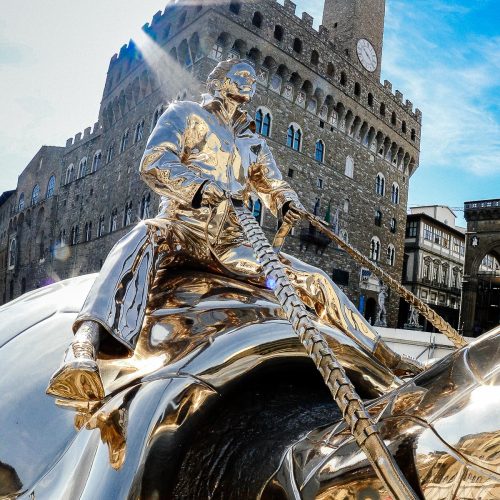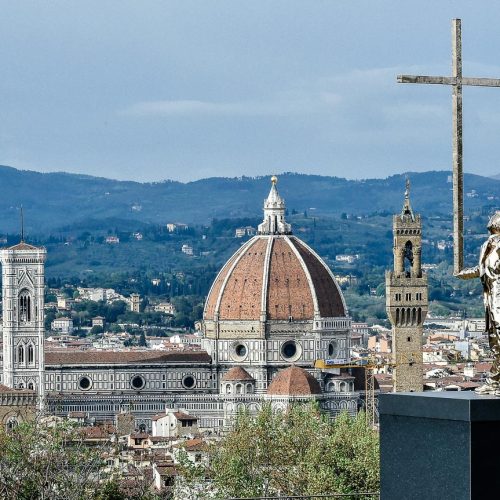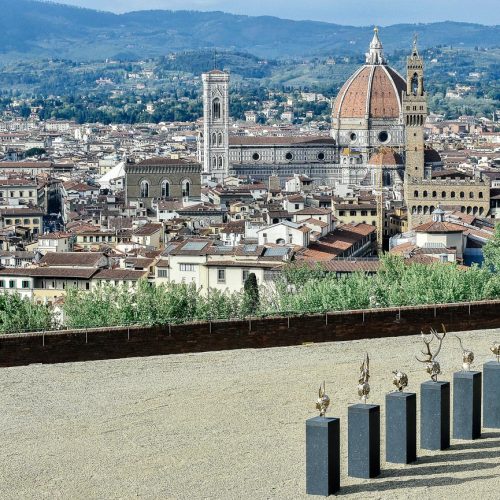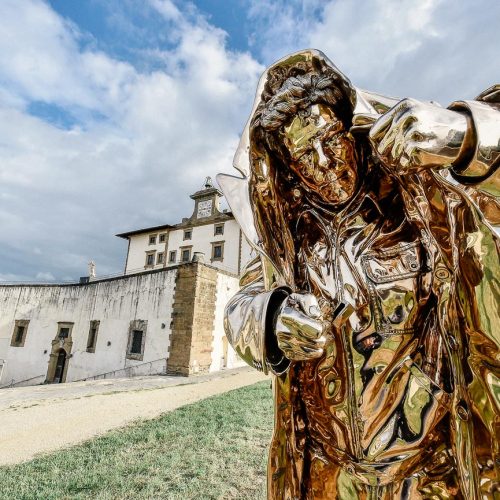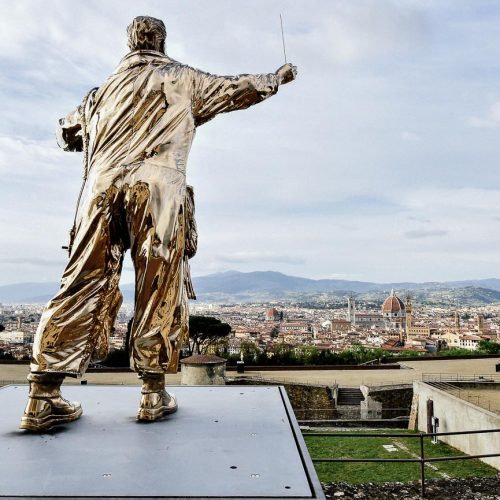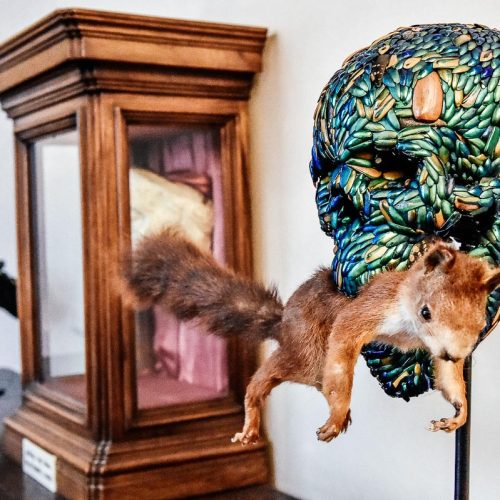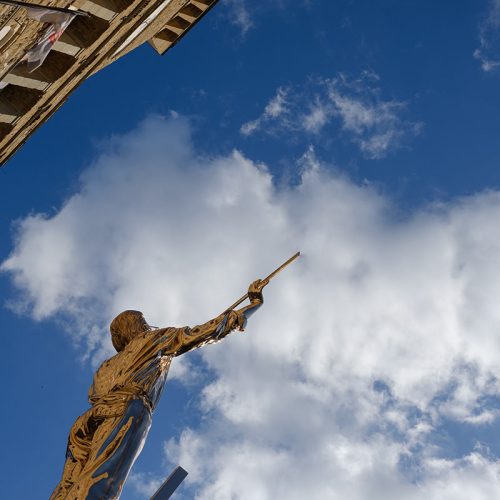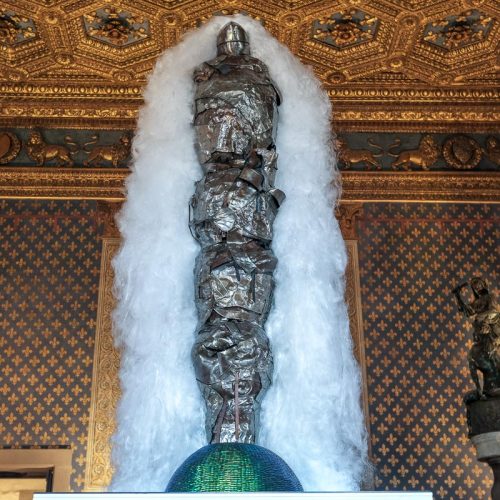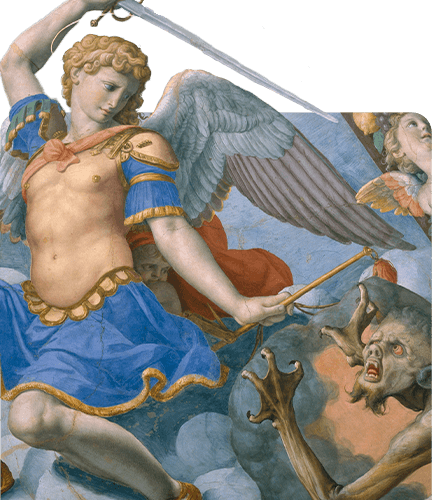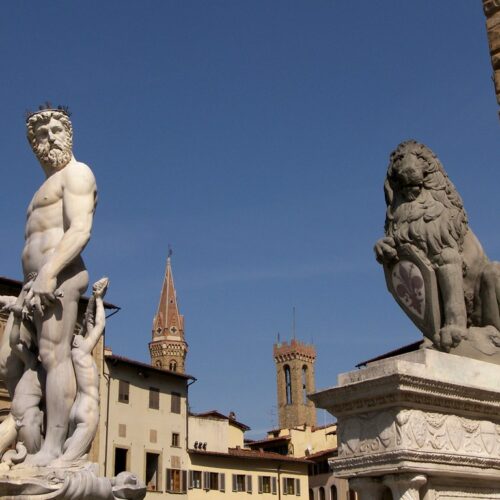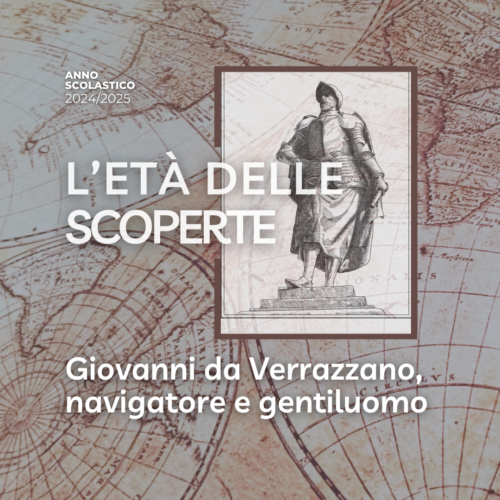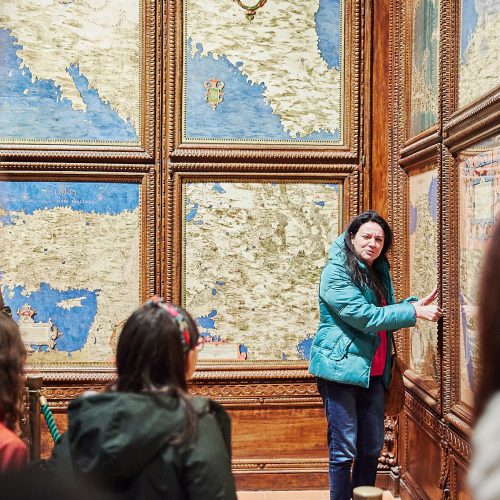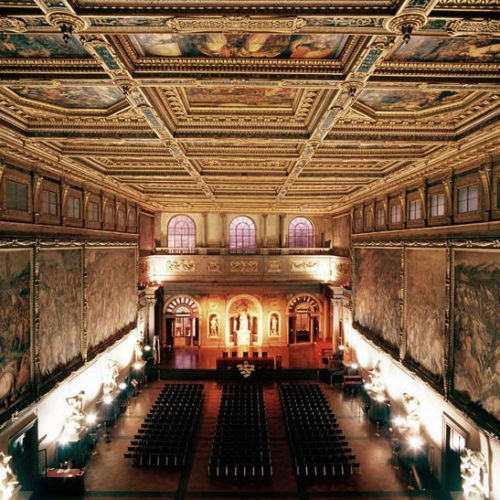Jan Fabre. Spiritual Guards
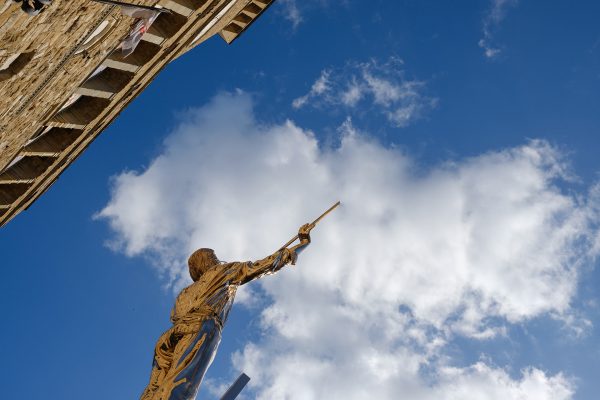
al 15 Aprile 16
La grande mostra Jan Fabre. Spiritual Guards, promossa dal Comune di Firenze, si sviluppa tra Forte di Belvedere, Palazzo Vecchio e Piazza della Signoria. Si tratta di una delle più complesse e articolate mostre in spazi pubblici italiani realizzata dall’artista e creatore teatrale fiammingo. Per la prima volta in assoluto un artista vivente si cimenta contemporaneamente in tre luoghi di eccezionale valore storico e artistico. Sono esposti un centinaio di lavori realizzati da Fabre tra il 1978 e il 2016: sculture in bronzo, installazioni di gusci di scarabei, lavori in cera e film che documentano le sue performance. Fabre presenta anche due opere inedite, pensate appositamente per questa occasione. L’anteprima è stata un evento di straordinario impatto visivo e dai forti connotati simbolici. Dalla mattina del 15 aprile, infatti, ben due sculture in bronzo di Fabre sono entrate a far par parte – temporaneamente – di quel museo a cielo aperto che è Piazza Signoria.
Una di queste, Searching for Utopia, di eccezionali dimensioni, si pone in dialogo con il monumento equestre di Cosimo I, capolavoro rinascimentale del Giambologna; mentre la seconda, The man who measures the clouds (American version, 18 years older), è innalzata sull’Arengario, o Ringhiera, di Palazzo Vecchio, tra le copie del David di Michelangelo e della Giuditta di Donatello. In entrambe le opere si riconosce l’autoritratto dell’artista, nella doppia veste di cavaliere e guardiano, come tramite tra terra e cielo, tra forze naturali e dello spirito. Ad una storia dell’arte che si è messa anche a disposizione del potere politico ed economico – come quella di Piazza Signoria con i suoi giganti di marmo (David, Ercole, Nettuno) e con le sue rappresentazioni bibliche, mitologiche o del genius loci (Giuditta, Perseo, Marzocco) – Jan Fabre oppone un’arte che vuole rappresentare e incarnare il potere dell’immaginazione, la missione dell’artista come “spiritual guard”. E lo fa in una piazza che dal Rinascimento in poi è stata pensata e usata come agorà e palcoscenico figurativo, che da allora è diventata luogo paradigmatico del rapporto tra arte e spazio pubblico, e dove è stata configurata in modo esemplare la funzione simbolica-spettacolare del monumento moderno.
Sempre dal 15 aprile sono visibili in Palazzo Vecchio una serie di sculture che dialogano con gli affreschi e i manufatti conservati in alcune sale del percorso museale del palazzo, in particolare quelle del Quartiere di Eleonora, assieme alla Sala dell’Udienza e alla Sala dei Gigli. Tra le opere esposte anche un grande mappamondo (2.50 m di diametro) rivestito interamente di scarabei dal carapace cangiante, la cui forma e dimensione sono state ispirate proprio dal celebre globo conservato nella Sala delle Mappe geografiche, opera cinquecentesca di Ignazio Danti.
Il 14 maggio, aprirà la mostra al Forte di Belvedere, dove tra i bastioni e la palazzina saranno presentate circa sessanta opere in bronzo e cera, oltre a una serie di film incentrati su alcune storiche performance dell’artista. Le curatrici Melania Rossi e Joanna De Vos, insieme al direttore artistico del progetto Sergio Risaliti, hanno scelto il Forte Belvedere come nucleo tematico dell’esposizione Jan Fabre. Spiritual Guards, per le sue caratteristiche spaziali e storiche. Una fortificazione che nel tempo è servita per difendere Firenze dalle minacce esterne, ma anche per proteggere la famiglia dei Medici in tempi di rivolte cittadine. Un luogo di difesa dall’esterno e dall’interno quindi, che suggerisce un percorso attraverso la vita, le ambizioni e le angosce dei potenti signori medicei e che allude a opposte percezioni e sensazioni umane come quelle di controllo e abbandono, ma anche a bisogni e desideri contrapposti come quelli di protezione armata e di slancio spirituale, così profondi e radicati da condizionare le forme architettoniche e la configurazione dello spazio naturale. Soprattutto qui al Forte Belvedere dove è evidente la necessità di fortificarsi nella consapevolezza di restare pur sempre indifesi.
Biografia
Da più di 35 anni Jan Fabre (Anversa, 1958) è uno dei personaggi più significativi e innovativi sulla scena internazionale dell’arte contemporanea. Come artista visivo, creatore teatrale e autore ha dato vita a un mondo personale con regole e leggi proprie, ma anche con propri personaggi, simboli e motivi ricorrenti.
Influenzato dalle ricerche condotte dall’entomologo Jean-Henri Fabre (1823-1915), l’artista è affascinato dal mondo degli insetti e di altre creature viventi fin dalla tenera età. Alla fine degli anni settanta, studente presso la Royal Academy of Fine Arts e il Municipal Institute of Decorative Arts and Crafts, Fabre decide di ampliare il proprio campo di ricerca, estendendolo anche al corpo umano, alla sua fragilità e alla sua difesa. Le performance e le azioni intraprese dal 1976 ad oggi sono da considerarsi essenziali nel percorso artistico di Fabre. Il suo linguaggio fa ricorso a una vasta gamma di materiali e costituisce un mondo a se stante, popolato da corpi che esprimono la propria fisicità, erotismo e spiritualità, in equilibrio tra gli opposti che definiscono la stessa esistenza naturale. Il concetto di metamorfosi è fondamentale quando ci si confronta con il pensiero di Jan Fabre, pensiero in cui l’umano e l’animale interagiscono costantemente.
Il suo universo viene rivelato attraverso una serie di testi e appunti notturni pubblicati su più volumi nel suo Night Diary o Giornale notturno. Artista totale, Fabre è riuscito ad unire arte performativa e teatro; di quest’ultimo riesce a modificare il linguaggio stesso, portando sul palcoscenico azioni reali, svolte in un lasso di tempo reale. Dopo le sue produzioni storiche This is theatre as to be expected and foreseen (1982), della durata di otto ore, e The power of theatrical madness (1984) di quattro ore, l’artista eleva il proprio lavoro ad un livello ancora nuovo grazie alla sua monumentale produzione, della durata di 24 ore, dal titolo Mount Olympus: To glorify the cult of tragedy, a 24-hour performance (2015).
Jan Fabre si fa conoscere al grande pubblico a livello mondiale grazie all’opera del castello di Tivoli (1990) e attraverso una serie di altri lavori realizzati in siti di interesse storico, si pensi a Heaven of Delight (2002) presso il Palazzo Reale di Bruxelles, a The Gaze Within (The Hour Blue) (2011 – 2013) collocato sulla scalinata reale del museo di belle arti di Bruxelles, e ancora si consideri una delle sue ultime istallazioni nella cattedrale di Anversa, dal titolo The man who bears the cross (2015). L’artista è noto anche per le proprie personali, quali Homo Faber (KMSKA, Anversa, 2006), Hortus / Corpus (Kröller-Müller Museum, Otterlo, 2011) e Stigmata: Actions and Performances, 1976–2013 (MAXXI, Roma, 2013, M HKA, Anversa, 2015, MAC, Lione, 2016). È stato il primo artista vivente ad ottenere una mostra di grandi dimensioni presso il Louvre di Parigi (L’ange de la metamorphose, 2008). La nota serie dal titolo The Hour Blue (1977-1992) è stata esposta al Kunsthistorisches Museum di Vienna (2011), presso il Musée d’Art Moderne di Saint-Etienne (2012) e al Busan Museum of Art (2013). La ricerca sulla “parte del corpo più sexy”, ovvero il cervello, è stata presentata in una serie di personali dell’artista: Anthropology of a planet (Palazzo Benzon, Venezia, 2007), From the Cellar to the Attic, From the Feet to the Brain (Kunsthaus Bregenz, 2008; Arsenale Novissimo, Venezia, 2009) e PIETAS (Nuova Scuola Grande di Santa Maria della Misericordia, Venezia, 2011; Parkloods Park Spoor Noord (Anversa, 2012). Le due serie di mosaici realizzate con gusci di scarabei intitolate Tribute to Hieronymus Bosch in Congo (2011 – 2013) e Tribute to Belgian Congo (2010 – 2013) sono state esposte presso il PinchukArtCentre di Kiev (2013) e il Palais des Beaux-Arts a Lille (2013), saranno quindi portate a ‘s-Hertogenbosch nel 2016 in occasione del cinquecentesimo anniversario di Hieronymus Bosch. Al momento sta preparando un nuovo progetto per lo State Hermitage Museum in San Pietroburgo.

